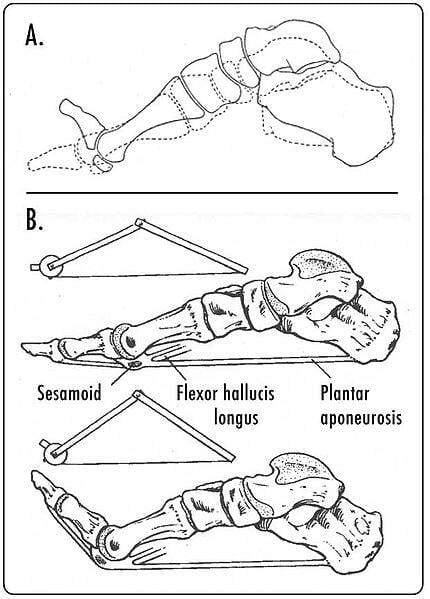Fix That Pain In The Heel!
What is plantar fasciitis?
Plantar fasciitis is a term given for the painful and inflamed flat tissue (also known as the plantar fascia or plantar aponeurosis) that connects your heel bone to your toes. The fascia acts as a shock absorber and supports the arch of the foot. With plantar fasciitis, there is an excessive strain placed on the fascia. This excessive strain causes tiny tears in the plantar fascia exceeding the body’s capacity to recover, resulting in inflammation. In turn, this causes weakness, irritation, swelling and pain along the plantar fascia, especially in weight-bearing activities.
bone to your toes. The fascia acts as a shock absorber and supports the arch of the foot. With plantar fasciitis, there is an excessive strain placed on the fascia. This excessive strain causes tiny tears in the plantar fascia exceeding the body’s capacity to recover, resulting in inflammation. In turn, this causes weakness, irritation, swelling and pain along the plantar fascia, especially in weight-bearing activities.
Do you have it?
Our clients with plantar fasciitis will commonly complain of pain under the heel or along the sole of the foot. It may occur on one foot or both. Pain and stiffness may be felt on the first step after sitting or lying down for too long, for example taking your first step in the morning when you first wake up. This happens because when your foot is at rest and in a non-weight bearing position, it is in a shortened state. When you first step down on it, the fascia is put on an immediate stretch causing pain. لعبة قمار Often, with a weight bearing activity, stiffness and pain will be noticed at the what does dianabol look like beginning but would become less or completely resolved after a few steps. This is so because after a few steps, the plantar fascia becomes more flexible. However, your foot may hurt more as the day goes on because of the increased build-up of stresses on the fascia. It may hurt the most when you walk for a long period or after you stand for a long time.
What causes it?

- Excessive foot pronation: Excessive pronation or inward rolling of the foot results in improper functioning of the plantar arch (tissue that runs from heel to toes) during walking or standing resulting in reduce shock absorption through the plantar fascia which in turn increases the tension on the plantar fascia.
- Tight calf muscles: Having tight calf muscles can cause excessive foot pronation contributing to excessive foot mobility which increases the level of stresses on the plantar fascia.
- High arched foot: A high arched foot lacks the normal joint mobility which reduces the foot’s ability to absorb shock from the ground, thereby increasing the stresses on the plantar fascia.
- Ill-fitting or worn out shoes: Wearing ill-fitting or worn out shoes may change the foot biomechanics, causing undue strain on the plantar fascia.
- Excessive walking and running on hard surfaces: This increases the shock transmitted to the plantar fascia, increasing the strain on the plantar fascia.
- Overweight: Being overweight increases the level of stresses applied to the fascia due to the added body weight on the foot, increasing the strain on the plantar fascia.
What are some of the treatment options?
Several conservative treatment options are available for patients with plantar fasciitis and includes the following:
Rest: Reduce the activities that cause you pain. Minimize walking or running on hard surfaces.
Ice: Apply ice on the affected region that is swollen, painful for about 15 minutes, 2-3 times daily.
Anti-inflammatory drugs: Taking anti-inflammatory may help to settle the inflammation and curb the pain. However, you may want to check with your doctor on the kinds to take if you have stomach or respiratory problems.
Injections: Steroid (cortisone) injections can be given to help reduce inflammation if the pain remains bad despite other measures. It may help to relieve the pain in some people but does not always cure the problem.
Exercises: Stretch your calves or your plantar fascia and do strengthening exercises for the intrinsic muscles of the foot. It is important to strengthen the intrinsic muscles of the foot so that the longitudinal arches of the foot will be stiffened during gait reducing excessive stresses on the plantar fascia.
Proper footwear: Wear shoes with thicker, well-cushioned mid-soles and heels and those with good arch supports. Avoid old or worn out shoes that may not give a good cushion to the heel. الرهان في سباق الخيل
Orthotics: Use orthotics to correct biomechanical faults in the foot during weight bearing activities.
Shockwave therapy: Some of our patients have benefited from Shockwave therapy.
Night splints: A special splint may be worn overnight to keep the calves and plantar fascia slightly stretched preventing tightening up of the plantar fascia overnight.
In cases that do not respond to conservative management, surgical release of the plantar fascia called plantar fasciotomy may be considered. Although the success rate of the procedure is about 70 to 90 percent in patients with plantar fasciitis, there are potential risk factors involved. مراهنات على كرة القدم The risks include nerve injury, infection, rupture of the plantar fascia and failure of any improvement of the condition.
